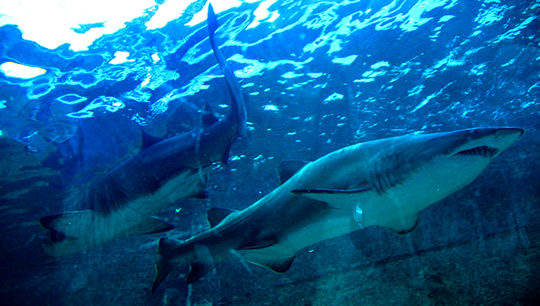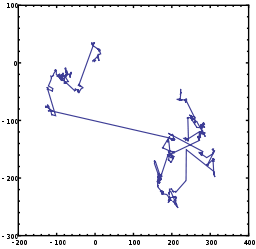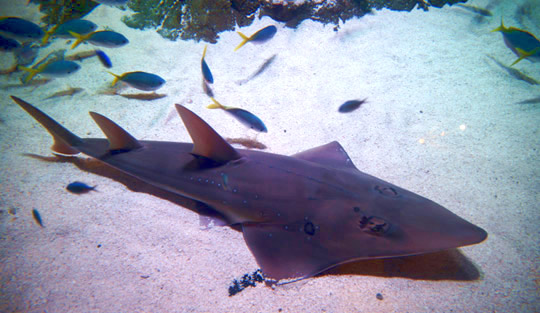
Image Copyright 2012 by Passy’s World of Mathematics
Passy’s World recently visited the Sydney Aquarium in Australia, which has one of the world’s best Shark exhibits.
In this lesson we look at some of the mathematics associated with these amazing creatures.

Image Copyright 2012 by Passy’s World of Mathematics
Mathematical Hunting Patterns
Sharks and other predatory sea animals actually use math when they hunt, according to scientific research.
The study, published online in the journal “Nature” in June 2010, found that some animals move in a specific pattern called a “Levy Walk”.
On a graph, the Levy Walk, which consists of rare, long forays in one direction, has a squiggly pattern and its shape stays the same no matter what the viewing scale is.
Computer models suggest Lévy flight is the optimal search pattern for predators in low-prey areas, and maximizes the chance of a random encounter. Visually speaking, a Lévy flight is characterized by short movements in random directions, interspersed with occasional longer trips in a particular direction.
Information Source: http://articles.nydailynews.com
Here is what a “Levy Walk” can typically look like:

Image Source: http://upload.wikimedia.org
Levi path lengths have been used to help make clusters of computers along a network more efficient, and are also one method of searching for vessels or people lost at sea, or for finding your friends in a large crowd at an outdoor concert!
Shark Sizes

Image Source: http://newspaper.li
The Great White Shark is the biggest Shark that most people have heard about, and it’s length can be up to six and a half meters long.
However Scientists have found remains of a much larger ancient shark called the “Megalodon”.
Using mathematics and computer modelling they have been able to determine the size of the Megalodon as much bigger than the Great White, as shown in the diagram below.

Image Source: http://newsimg.bbc.co.uk
Megalodon ate seals, whales, and tortoises, and it is believed Megalodons became extinct because Orca Killer Whales ate the food sources of the Magalodon, and Great White Sharks preyed on many baby Megalodon pups.
Here is a short Discovery Channel video about the Megalodon.
Biting Force of Shark Jaws

Image Source: http://bloximages.chicago2.vip.townnews.com
In the above photo scientists at Houston’s Science Museum construct a Megalodon Shark Jaw containing a total of 178 teeth in four rows, including 72 teeth that are actual Megalodon fossils. There is plenty of measuring and mathematics involved in getting a model like this looking as good as these guys have.
Note the mathematical Parabolic shape of the shark teeth. Shark fins are also half Parabolas, and so there is some very interesting mathematics going on in their body parts.
By looking at the mathematical distribution of stress and strain on shark jaws, scientific researchers have found that the largest great whites have a bite force of up to 1.8 tonnes, three times the biting force of an African Lion, and 20 times harder than a human can bite.
Dr Stephen Wroe of the University of New South Wales, used a technique known as finite element analysis to compare the skulls of the Great White with that of the prehistoric Megalodon.
The approach is a common one in advanced design and manufacturing, and allows engineers to test the performance of load-bearing materials, such as the metal in the body and wings of aeroplanes.
CT (X-ray) scans were taken of Megalodon remains to construct a high-resolution digital model of the ancient shark’s head and jaws.
Megalodon’s biting force has been mathematically determined to be up to ten times more powerful than the Great White, which makes it 200 times more powerful than a human bite. It is estimated that Magalodon could bite down with a force of between 10.8 to 18.2 tonnes.
Dr Wroe’s research team said that biting with such force was quite a feat given that the jaws of these ancient creatures were made of flexible cartilage.
In contrast to most other fish, sharks’ skeletons are made up entirely of cartilage. Scientists think that cartilage, being a much lighter material than bone, is one adaptation that allows sharks to swim without the aid of a swim bladder.
The shark’s upper jaws can be dislocated: the whole upper and lower jaw pull out and forward as the shark twists and shakes its head from side to side to bite a chunk out of its prey.
These sharks feed on very large prey: the great white shark eats sea lions and the megalodon is thought to have eaten whales.
These sharks ambush their prey and immobilise them with a bite, then wait for them to die. They are actually delicate feeders and take care not to damage their teeth by biting down too hard on the large bones of their prey.
To keep their teeth sharp, sharks have a battery of them that is continually replaced. This is why they have rows of teeth in their huge mouth. These rows of teeth are also angled backwards so that their prey cannot escape.
It is the combination of their size, their razor-sharp teeth and the element of surprise that makes sharks such deadly predators.
Information Source: http://news.bbc.co.uk
The Guitar Fish

Image Copyright 2012 by Passy’s World of Mathematics
The fish in this picture is not actually a Shark.
It is a “Guitar Fish” which is one of Passy’s favorite fishes at the Sydney Aquarium. It’s triangular geometry is simply stunning.
Despite its shark like appearance, being grey with two large dorsal fins, guitar fish are actually quite harmless. They are found in shallow warm water areas of Australia.
If you are ever in Sydney Australia, then the Sydney “Sea Life” Aquarium is definitely worth a visit.
http://www.sydneyaquarium.com.au/
MAV Conference PowerPoint
To download the PowerPoint Presentation from the Mathematics Association of Victoria Conference, click the link below and save the file to your computer.
Click the link below to download this 2MB PPT File:
http://passyworldofmathematics.com/MAVconfPPTs/SharksMathPPTv1.pptx
Related Items
Ocean Mathematics – Overview
Mathematics of Ocean Waves and Surfing
Surfboard Geometry and Design
Tsunami Mathematics
Wave Power Mathematics
Mathematics of Ships at Sea
Satellite Tags Show How White Sharks Travel
Deep-Sea Sharks Have Habitats Mapped
If you enjoyed this post, why not get a free subscription to our website.
You can then receive notifications of new pages directly to your email address.
Go to the subscribe area on the right hand sidebar, fill in your email address and then click the “Subscribe” button.
To find out exactly how free subscription works, click the following link:
If you would like to submit an idea for an article, or be a guest writer on our blog, then please email us at the hotmail address shown in the right hand side bar of this page.
Feel free to link to any of our Lessons, share them on social networking sites, or use them on Learning Management Systems in Schools.
Like Us on Facebook
Our Facebook page has many additional items which are not posted to this website.
These include items of mathematical interest, funny math pictures and cartoons, as well as occassional glimpses into the personal life of “Passy”.
Check it out at the following link:
https://www.facebook.com/PassysWorldOfMathematics
While you are there, LIKE the page so you can receive our FB updates to your Facebook News Feed.
Help Passy’s World Grow
Each day Passy’s World provides hundreds of people with mathematics lessons free of charge.
Help us to maintain this free service and keep it growing.
Donate any amount from $2 upwards through PayPal by clicking the PayPal image below. Thank you!
PayPal does accept Credit Cards, but you will have to supply an email address and password so that PayPal can create a PayPal account for you to process the transaction through. There will be no processing fee charged to you by this action, as PayPal deducts a fee from your donation before it reaches Passy’s World.
Enjoy,
Passy



Pingback: Mathematics of the Melbourne Cup | Passy's World of Mathematics
Pingback: Geometry in the Animal Kingdom | Passy's World of Mathematics
Pingback: Jobs With Geometry | Passy's World of Mathematics
Pingback: Mathematics of Surfing | Passy's WordPress Test Blog
Pingback: Wave Power | Passy's WordPress Test Blog
Pingback: Surfboard Geometry and Design | Passy's WordPress Test Blog
Pingback: Mathematics of Ships at Sea | Passy's WordPress Test Blog
Pingback: Ocean Mathematics | Passy's WordPress Test Blog
Pingback: Wave Power Mathematics | Passy's World of Mathematics
Pingback: Ocean Mathematics | Passy's World of Mathematics
Pingback: Mathematics of Ocean Waves and Surfing | Passy's World of Mathematics
Pingback: Surfboard Geometry and Design | Passy's World of Mathematics
Pingback: Mathematics of Ships at Sea | Passy's World of Mathematics